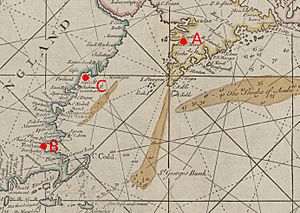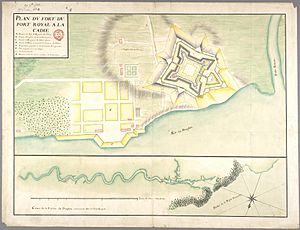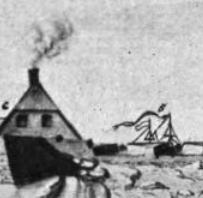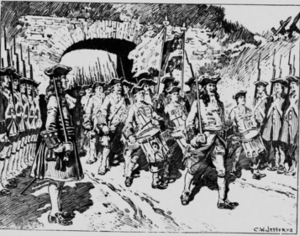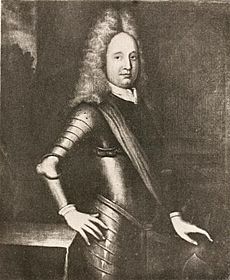Siege of Port Royal (1710) facts for kids
The siege of Port Royal (October 5–13, 1710), also known as the Conquest of Acadia, was an important military event. British forces, led by Francis Nicholson, attacked the French capital of Port Royal in Acadia (which is now Nova Scotia). The French garrison and their allies, the Wabanaki Confederacy, were led by Daniel d'Auger de Subercase.
This British victory was a big deal. It was the first time the British took and kept a French colony. It also marked the start of permanent British control over the main part of Acadia. The British renamed this area Nova Scotia. After the French gave up, the British took over the fort and renamed it Annapolis Royal.
This siege was the third time the British tried to capture the Acadian capital during Queen Anne's War. Its outcome had a huge impact for the next 50 years. It was a key part of the peace talks between France and Britain from 1711 to 1713. It led to the creation of a new colony, Nova Scotia. It also raised big questions about what would happen to the Acadians and the Mi'kmaq people living there.
The Conquest of Acadia was a founding moment for Canada's history. It set the stage for later British victories at Louisbourg and Quebec in the mid-1700s.
Quick facts for kids Siege of Port Royal |
|||||||
|---|---|---|---|---|---|---|---|
| Part of Queen Anne's War | |||||||
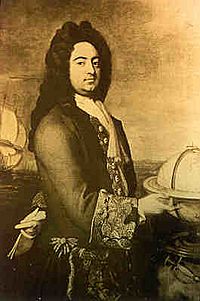 Portrait believed to be of Francis Nicholson, by Michael Dahl, c. 1710 |
|||||||
|
|||||||
| Belligerents | |||||||
|
|||||||
| Commanders and leaders | |||||||
| Francis Nicholson Samuel Vetch |
Daniel d'Auger de Subercase Simon-Pierre Denys de Bonaventure |
||||||
| Strength | |||||||
| about 2,000 regular and provincial soldiers | fewer than 300 | ||||||
| Casualties and losses | |||||||
| unknown | unknown | ||||||
Contents
Why Port Royal Was Important
Port Royal was the main city of the French colony of Acadia. It had been important since the French first settled the area in 1604. Because of this, it often became a place of fighting between English and French colonists.
In 1613, English raiders destroyed it, but it was rebuilt. In 1690, forces from Province of Massachusetts Bay captured it. However, it was given back to France by the Treaty of Ryswick.
Early Attacks on Port Royal
When the War of the Spanish Succession started in 1702, both sides got ready for war again. Acadia's governor, Jacques-François de Monbeton de Brouillan, had already started building a strong stone and earth fort in 1701. It was mostly finished by 1704.
After a French attack on Deerfield in Massachusetts in February 1704, the English in Boston planned their own attack on Acadia. This happened in May. Led by Benjamin Church, they attacked Acadian towns like Grand Pré. It's not clear if Church's group actually attacked Port Royal itself. Church said they thought about it but decided not to. French records say there was a small attack.
When Daniel d'Auger de Subercase became governor of Acadia in 1706, he started attacking the English. He encouraged Native American raids against English towns in New England. He also supported privateers from Port Royal. Privateers were like legal pirates who attacked enemy ships. These privateers were very good at their job. The English fishing fleet on the Grand Banks shrank by 80 percent between 1702 and 1707. Some English coastal towns were also attacked.
English merchants in Boston had traded with Port Royal for a long time. Some of this trade continued illegally after the war began. But the war was hurting business. Some merchants started demanding action. People were also angry that Massachusetts' defenses couldn't stop the French and Native American raids. Massachusetts Bay Governor Joseph Dudley had asked London for help many times but got none. So, he decided to act on his own. In the spring of 1707, he sent an expedition to attack Port Royal. This expedition tried twice to take Port Royal. Both attempts failed, even though the English had many more soldiers.
British Plan for Attack
In the years that followed, France didn't send much help to Acadia. But the British gathered larger and better-organized forces for the fight in North America. Samuel Vetch, a Scottish businessman with ties to the colonies, went to London in 1708. He asked Queen Anne for military help to conquer all of New France. She agreed to a "great enterprise" in 1709 to conquer Acadia and Canada. But the promised military support never arrived, so the plan was canceled.
Vetch and Francis Nicholson, an Englishman who had been a governor in Maryland and Virginia, went back to England. They asked the queen for help again. Four Native American chiefs went with them, and they caused a stir in London. Nicholson and Vetch successfully argued that the colonies needed British military support to take Port Royal.
Nicholson arrived in Boston on July 15, 1710. He had a special order from the queen. It named him "General and Commander-in-Chief of all... Forces... for the reducing of Port Royal in Nova Scotia." Besides 400 marines from England, four New England colonies raised their own soldiers. Massachusetts Bay provided 900, Rhode Island 180, Connecticut 300, and New Hampshire 100. Some of these colonial soldiers were trained in siege warfare by Paul Mascarene, a British Army officer. A group of Iroquois warriors also joined to act as scouts.
When the fleet sailed on September 29, it had 36 transport ships, two bomb galleys (ships that could fire bombs), and five warships. Two ships, HMS Falmouth and HMS Dragon, came from England. HMS Feversham and HMS Lowestoft came from New York. They joined HMS Chester, which was already in Boston. Nicholson sent HMS Chester ahead to block the Digby Gut. This was the waterway that led to Port Royal.
Port Royal's Defenses
Port Royal was defended by about 300 soldiers. Many of them were new recruits from France and not well trained. Governor Subercase had worked to make the defenses better since the 1707 attacks. In 1708, he built a new powder magazine (where gunpowder was stored) and barracks (soldiers' living quarters) that could withstand bombs. He also cleared trees from the river banks so attackers couldn't hide. He finished building another ship to help defend by sea. He also used privateers very successfully against New England fishing and shipping. From prisoners taken by the privateers, he learned that new attacks on Port Royal were always being planned in 1708 and 1709.
The Siege Begins
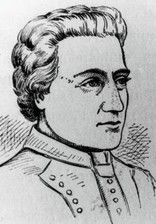
As the British fleet sailed north, it met a ship from Captain Thomas Matthews of the Chester. This ship carried French soldiers who had left their army. They reported that morale was very low among the French defenders. Nicholson sent the ship ahead with a transport vessel. When they entered Digby Gut, they were fired upon by some Mi'kmaq groups on the shore. The British ships fired back with their cannons, but no one was hurt on either side. On October 5, the main British fleet arrived at Goat Island, about 10 kilometers (6 miles) below Port Royal. That afternoon, a transport ship called Caesar got stuck while trying to enter the Annapolis River. It was eventually pushed onto rocks. Its captain, some crew, and 23 soldiers died. A company commander and about 25 others managed to get to shore.
The next day, October 6, British marines started landing both north and south of the fort and the town. The northern force was joined by four New England regiments led by Colonel Vetch. Nicholson led the rest of the New England troops as part of the southern force. The landings happened without problems. Fire from the fort was answered by one of the British fleet's bomb ships from far away.
Later stories of the siege said Vetch's group was part of a plan to surround the fort. But records from that time say Vetch wanted his own command, separate from Nicholson. These records also say Vetch never got close enough to the fort's guns until after the siege ended. His attempts to set up a battery of mortars (small cannons) in a muddy area across Allain's Creek from the fort were stopped by cannon fire.
The southern force faced guerrilla-style fighting outside the fort. Acadian and Native American defenders fired small guns from houses and wooded areas. They also faced fire from the fort. This fighting killed three British soldiers. But the defenders could not stop the British on the south side from setting up a camp about 400 yards (365 meters) from the fort.
Over the next four days, the British brought their cannons ashore and moved them to the camp. Fire from the fort and its supporters outside continued. The British bomb ships caused a lot of damage inside the fort with their nightly attacks.
With new British cannon batteries about to open fire, Subercase sent an officer with a white flag (a sign for talks) on October 10. The talks started badly because the officer wasn't properly announced by a drummer. Things got worse from there. Each side ended up holding an officer from the other side, mostly over rules of military manners. The British kept working on their siege.
By October 12, the siege trenches had moved closer. Cannons that were within 300 feet (91 meters) of the fort began firing. Nicholson sent Subercase a demand to surrender, and talks started again. By the end of the day, they agreed on the terms of surrender. It was formally signed the next day. The French soldiers were allowed to leave the fort with all military honors. This meant they could keep their weapons and belongings, with drums beating and flags flying. The British agreed to transport the French soldiers to France. The agreement also had special rules to protect the local people. These rules said that "Inhabitants within Cannon shot of the Fort" could stay on their properties for up to two years if they wanted. They just had to agree to be loyal to the British Crown.
What Happened Next
The British officially took control of Port Royal in a ceremony on October 16. They renamed the place Annapolis Royal, in honor of their queen. Samuel Vetch became the new governor of Nova Scotia. Massachusetts and New Hampshire celebrated with a day of public thanksgiving.
The first attempt to take back Annapolis Royal happened the next year. After a small fight (a skirmish) where some British soldiers were ambushed, Bernard-Anselme d'Abbadie de Saint-Castin led 200 Acadians and Native American warriors in a siege of the fort. But they didn't succeed.
The capture of Port Royal meant the end of French rule in the main part of Acadia. It started a long fight for control of the area that lasted until the British won the Seven Years' War. The future of Acadia was one of the most difficult issues in the talks that led to the 1713 Treaty of Utrecht. It almost caused another war. French negotiators couldn't get Acadia back. But they did keep Isle Saint-Jean (now Prince Edward Island) and Île Royale (now Cape Breton Island). These islands were important for access to the rich Atlantic fisheries.
The people of Acadia were in a tough spot after the conquest. The British often asked them to promise loyalty to the British Crown. But many refused to promise to fight against the French. They preferred to say they were neutral. Because of this and other reasons, hundreds of Acadians left the main part of Nova Scotia over the next ten years. Most of them avoided the main French settlements and went to French-controlled Isle Saint-Jean.
The border of Acadia was not clearly drawn by the Treaty of Utrecht. This caused ongoing arguments between the British and French, especially on the Isthmus of Chignecto. Both sides eventually built forts there. The French believed "ancient boundaries" meant only the peninsula of present-day Nova Scotia. This would exclude the mainland between New England and the St. Lawrence River, as well as Île Saint-Jean and Cape Breton. This helped the Native American groups like the Abenaki, Malecites, and Mi'kmaq keep control over their old hunting grounds.
In 1746, a large French expedition was organized under the command of the Duc d'Anville. This expedition had 20 warships, 21 smaller warships (frigates), and 32 transport ships. It carried 800 cannons, 3,000 soldiers, and 10,000 marines. The plan was to retake Louisbourg and then Annapolis Royal. However, after a three-month journey and the fleet getting scattered, the expedition was a disaster for the French. They never tried to recapture Port Royal again.
The argument over the land was not fully settled until the British conquered New France in 1760. The unofficial border between the British and French in this dispute (the Missaguash River) now forms the border between the Canadian provinces of Nova Scotia and New Brunswick.
Who Fought: British Forces
- Colonel Francis Nicholson
- Fleet
- HMS Dragon, 50 guns, Captain George Martin
- HMS Falmouth, 50 guns, Captain Walter Riddell
- HMS Chester, 50 guns, Captain Thomas Mathews
- HMS Lowestoffe, 32 guns, Captain George Gordon
- HMS Feversham, 35 guns, Captain Robert Paston
- HMS Starr, Commander Thomas Rochfort
- Province Galley, Captain Cyprian Southack
- Land forces
- Colonel Samuel Vetch, Adjutant General
- Captain Walter Elliot, Brigade Major
- Battalion of Marines, Colonel Robert Reading
- Hobby's Regiment (Massachusetts Bay), Colonel Sir Charles Hobby.
- Tailer's Regiment (Massachusetts Bay), Colonel William Tailer.
- Whiting's Regiment (Connecticut), Colonel William Whiting.
- Walton's Regiment (New Hampshire), Colonel Shadrach Walton.
- Company of Gunner and Matrosses, Colonel Samuel Vetch, Captain.
- Company of Indian Scouts (Iroquois Indians), Major of Scouts John Livingston, Captain.
Who Fought: French Forces
- Captain Daniel d'Auger de Subercase, Governor of Acadia
- 150 soldiers of the Compagnies Franches de la Marine
- 100 men of the Acadian Militia
- Some Canadians
- Some privateers
|
See also
 In Spanish: Sitio de Port Royal para niños
In Spanish: Sitio de Port Royal para niños


